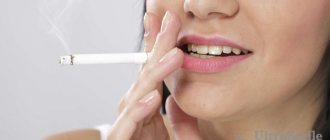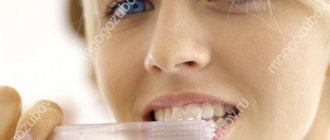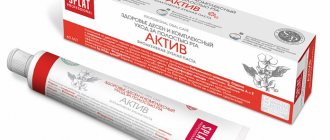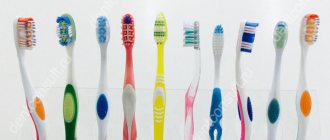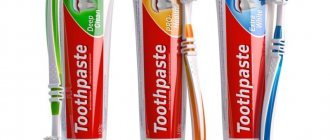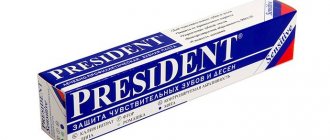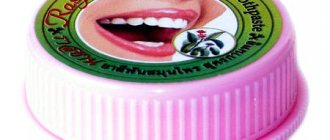- What does "organic" mean?
- How to determine natural toothpaste by composition
- The benefits and effectiveness of organic paste
- Which pasta to choose
- Organic pastes
Every year the popularity of a healthy lifestyle and reasonable consumption is growing. People choose environmentally friendly products to maintain their health, which is why organic products are in high demand. This also applies to oral hygiene. Organic toothpastes cleanse teeth of plaque, can relieve bleeding gums and enamel sensitivity, and do not contain harmful additives. What organic pastes are made from and what to look for when choosing them, you will learn from this article.
Mint
Peppermint or lemon balm extract is the most common natural ingredient found in toothpastes. Mint has antibacterial, antioxidant, antiallergenic, analgesic, anesthetic and anti-inflammatory effects. The leaves of this plant are a storehouse of natural benefits, and the taste of mint, unlike eucalyptus or menthol, is considered pleasant by almost every person. In toothpastes, mint extract is responsible for its pleasant taste, as well as its refreshing and antibacterial effect. You will find the mint component in “Vanilla and Mint” pastes from JASON,.
Therapeutic and prophylactic toothpastes for every day with natural ingredients
Toothpaste is designed to cleanse the oral cavity of food debris, suppress the growth of pathogenic microorganisms, thereby preventing the destruction of tooth enamel, inflammation of the mucous membranes and gums of the oral cavity, and contain components of “nutrition” and strengthening of the components of the oral cavity.
Toothpaste for preserving gums (prevention of periodontitis and periodontal disease) and maintaining pH balance in the oral cavity.
There are no age restrictions for use. (https://nspclub.org/?a=291 ( SECTION: NSP products SUB-SECTION: Toothpastes)
Toothpaste for natural protection of tooth enamel from cariogenic bacteria and maintaining pH balance in the oral cavity. (https://nspclub.org /?a=206 ( SECTION: NSP Products SUB SECTION: Toothpastes)
Since toothpaste is the main means of hygiene of the oral mucosa, it must meet a number of specific requirements:
- be safe for the mucous membranes and the body;
- It is good to remove plaque without damaging the gums and tooth enamel;
- prevent plaque from occurring;
- influence the mineralization of teeth;
- strengthen the protective functions of the oral mucosa;
- have antimicrobial and periodontal protective properties;
- have a deodorizing and refreshing effect.
Throughout his entire adult life, a person on average “absorbs” from two to five kilograms of toothpaste! Scientists have found that young children reflexively swallow about 40% of toothpaste when brushing their teeth. It is important to understand that from the oral cavity, thanks to the mucous membrane, iodine, copper, iron, potassium, fluorine, sodium, zinc, vitamins, amino acids, etc., if they are components of toothpaste, enter the bloodstream in a matter of seconds. Thus, beneficial substances penetrate into the oral mucosa, then into the blood capillaries, then into the pulp of the tooth, and from the pulp into the enamel. But along with useful substances, we also “eat” antibiotics (triclosan, chlorhexedine, hexedine, metranidazole), flavorings, sweeteners (potassium acesulfate, sodium cyclomate, aspartame), sodium lauryl and laureth sulfate.
It is the composition of the toothpaste that determines how long we can use this or that toothpaste without harm to the body. The ingredients of chemical synthesis of toothpaste efficiently remove plaque accumulating on enamel, effectively suppress pathogenic microflora, and have good whitening properties. Active chemical components act quickly, which is an important advantage, but at the same time they are not able to fully “nourish” the gums and adjacent tissues, restore them, soothe and protect them. Moreover, with prolonged use of an artificial composition, the microflora becomes accustomed to synthetic substances, as a result of which the anti-inflammatory properties and, accordingly, the effect of use are reduced. The period of use of such toothpastes is determined by the doctor, but in general it is no more than 3-4 weeks. The instructions for use indicate that after brushing your teeth, you must rinse your mouth thoroughly. This is not surprising - getting remnants of toothpaste into the body is not only undesirable, but even dangerous. Such pastes are contraindicated for children.
Toothpastes of combined compositions (containing both synthetic and natural ingredients) are more acceptable for use. Substances of natural origin compensate for the aggressive effect of artificial components and have a beneficial effect on the mucous membrane and adjacent tissues, making care more complete and gentle. But the instructions also say to rinse your mouth thoroughly after using toothpaste, so their use is not safe. It should be noted that in most pastes, natural ingredients are presented in very modest quantities.
The safest for health are pastes with natural ingredients; they are indicated for long-term use by both adults and children. All-natural toothpastes are very rare. To find a suitable product, you need to be patient and study the ingredients yourself, abstracting from advertising.
The question arises: is it possible to effectively and efficiently clean tooth enamel and mucous membranes from food debris and bacterial plaque, influence the local pH balance, and have a beneficial effect on the gums, relying only on natural ingredients? Here is an example of chemically synthesized ingredients and natural ingredients of the same purpose in toothpastes.
| Ingredients of chemical origin | Ingredients of natural origin | |
| To create taste | saccharin, aspartame, potassium acesulfate, sodium cyclomate, etc. | sorbitol and stevia |
| To add flavor | flavorings similar or identical to natural | mint extract |
| Foaming substance | sodium lauryl sulfate, sodium laureth sulfate | sodium lauryl sarcosinate |
| Abrasives | baking soda (fine sodium bicarbonate), natural chalk (purified calcium carbonate), hydrated silica | |
| Anti-inflammatory and antimicrobial substances | chlorhexidine, metronidazole, hexetidine, triclosan, hexidine | aloe vera, myrrh, Irish moss extract, goldenseal, black tea leaves, astragalus and black elderberry |
Let's take a closer look at natural toothpastes from the manufacturer NSP.
Natural toothpaste Sunshine Bright (manufacturer NSP) with Camellia sinensis leaf extract (green tea).
Has regenerating properties. The composition contains components for “nourishing” the beneficial microflora of the mouth, tooth enamel, oral mucosa and adjacent tissues. Prevents periodontal diseases.
Full composition:
- Astragalus (14.3 mg per 100 g) – root concentrate. This ingredient has protective, anti-inflammatory properties, increases local immunity and has regenerating, antiviral and antibacterial effects.
- Green tea (14.3 mg per 100 g) – a concentrate of Camellia sinensis leaves, due to its high content of organic fluorine, is a means of protecting tooth enamel from caries. It has a beneficial effect on the microflora of the oral cavity, strengthens gums, freshens breath and prevents bleeding gums.
- Canadian goldenseal (14.3 mg per 100 g) – concentrate. This plant has an antiseptic, anti-inflammatory, hemostatic effect. It is called one of the best natural “antibiotics”. The dried roots of this plant have been used since ancient times in the treatment of infected and/or inflamed mucous membranes. Canadian goldenseal is used in dentistry to prevent and treat periodontitis.
- Corn oil (15 mg per 100 g). The emollient effect of corn oil is ideal for healing microtraumas of the mouth and skin.
- Icelandic moss (14.3 mg per 100 g) – extract. Contains tannins, iodine about 5% - lichen acids (usnic lichen acid is a powerful antibiotic). The effect of Icelandic moss is to protect the gums from irritation, disinfect and regenerate. Used in dentistry for the prevention and treatment of stomatitis.
- Stevia (700 mg per 100 g) is rich in steviosides, which, in the absence of calories, are 15 times sweeter than sugar. In toothpastes, this property of stevia is used to create a pleasant light taste and aftertaste. The main advantage of steviosides is the ability to slow down the growth of Streptococcus sorbinus and Pseudomonas in the oral cavity. That is why steviosides have become an important component of toothpastes.
- Glycerin (12 g per 100 g) is a liquid binding component and foam stabilizer. It is known that 1 molecule of glycerol binds 10 molecules of water. Glycerin also has excellent emollient properties. In toothpaste mixtures, glycerin is used to obtain a paste-like consistency. In addition, it makes the pasta taste more pleasant. In concentrated form, glycerin can have a disinfecting effect.
- Aloe vera (10 mg per 100 g). The plant is famous for salicylic acid, essential oils, phytoncides, which causes bactericidal (eliminates staphylococcus, E. coli and streptococci), wound healing, anti-inflammatory effects, and accelerates regeneration processes. Aloe increases the resistance of the mucous membrane to the action of harmful agents.
- Black elderberry (14.3 mg per 100 g) – fruit extract. The extract is rich in tannins and organic acids (especially malic). Tannins penetrating through the mucous membrane prevent irritation of nerve endings and underlying tissues. Elderberry fruits also contain anthocyanins, which increase the elasticity of capillaries.
- Carrageenan (500 mg per 100 g) is a gel-forming polysaccharide. This component is obtained from sea red algae. Carrageenan contains pectic substances (55% - 80%), iodine, chlorine, organic acids, bromine, and sulfur. Organic sulfur can relieve toothache, have a disinfecting effect, inhibit bacteria that provoke the development of periodontal disease and caries, and also strengthen dental tissues and gums.
- Myrrh (14.3 mg per 100 g) – resin. It is a natural antiseptic, contains healing essential oils with antifungal, antiviral and antibacterial effects, and has regenerating properties. Myrrh removes bad breath. Today it is successfully used in dentistry to eliminate inflammation, gingivitis, periodontal disease, stomatitis and bleeding gums.
- Mint (1.2 g per 100 g) – extract. The plant contains menthol, which affects nerve endings and causes a slight tingling sensation and a slightly noticeable chill; mint extract helps strengthen capillaries. Its antimicrobial property is directed against Staphylococcus aureus and some spore-forming bacteria, which helps prevent fermentation processes. Since ancient times, peppermint has been used as a mouth rinse and is used for gingivitis, hemorrhages, and stomatitis.
- Sodium lauryl sarcosinate (1.2 g per 100 g) is a surfactant extracted from the natural amino acid sarcosine, harmless to mucous membranes and skin, even sensitive ones, which qualitatively distinguishes it from the famous sodium lauryl sulfate and laureth sulfate. It is used in cosmetic formulations as a mild foaming agent to remove bacteria, dirt and grease.
- Sodium hydroxide (650 mg per 100 g). Regulates acidity, is an emulsifier, and is also used to obtain a delicate consistency of the mixture. This component is actively used in the manufacture of food and cosmetic products.
- Sodium bicarbonate (2 g per 100 g) - baking soda. Alkalinizes the oral cavity, preventing the growth and development of fungi and bacteria, neutralizes bacterial acids that damage tooth enamel. Soda has antiseptic, anti-inflammatory and local antihistamine properties, deodorizes the oral cavity. Used to gently clean plaque from the surface of teeth.
- Silicon hydroxide (22 g per 100 g) is a hydrated form of silicon. It is used as a whitening component that cleans teeth well of plaque without causing harm to the enamel, which compares favorably with chalk and aluminum compounds. Silicon hydroxide destroys the bacterial film on the teeth, leaving in return a smooth surface that prevents the accumulation of new bacteria on the enamel surface for a long time. This substance also improves the overall texture of the paste and prevents it from hardening.
- Sorbitol (44 g per 100 g) is a sweetener extracted from fruits, algae and starchy fruits, contains a minimum of calories and does not cause caries.
- Cellulose resin (600 mg per 100 g). This component is obtained from cellulose. The resin has binding properties, regulates viscosity and stabilizes the emulsion, and is endowed with sorption ability.
- Calcium carbonate (1.5 g per 100 g) is highly purified chalk, insoluble in water. Removes food debris and stains, polishes the surface of teeth, and has alkalizing properties.
- Purified water (13.7 g per 100 g) is a solvent that provides the required texture of the paste. It is worth noting that the quality of water is strictly controlled. Before entering the toothpaste, the water undergoes a special purification, which ensures an absolute level of purity.
8th scientific and practical conference “Health and nutrition in the 21st century”. Speech by dentist Grineva-Kichi O.A., Kyiv.
Purpose of the experiment:
a) check the effectiveness of natural paste with leaves of Camellia sinensis (green tea) b) check the effectiveness of bleeding gums; c) identify the possibility of preventing periodontitis when using this toothpaste.
The experiment involved 65 volunteers of various ages - 18-60 years old with generalized periodontitis of the first degree, who were divided into groups.
1st group - 35 people used toothpaste with extract of Camellia sinensis (green tea) leaves in their daily care; 2nd group - 30 people who used fluoride-containing toothpaste
Before the start of the study, absolutely all patients underwent a training session, where they were told in detail about individual oral hygiene and Green-Vermilion OHIS indices were checked, and each volunteer received professional teeth cleaning. At the end of the 3-month experiment, specialists again checked the condition of the oral cavity using a special Green-Vermilion OHIS index.
Hygienic qualities of toothpaste with Camellia sinensis (green tea) leaves.
The initial examination showed that the dental condition of patients in the two groups was approximately the same. It was located at the top o.
Within a month the indicators had changed.
In the first group, where patients used toothpaste with Camellia sinensis (green tea) leaves, the indicators moved to the upper range of “good hygiene”.
There were no changes in the second group.
To summarize, we can say that this natural toothpaste really meets high cleansing hygienic standards.
The effect of toothpaste with Camellia sinensis leaves (green tea) on the condition of the gums.
The anti-inflammatory property of toothpaste was assessed clinically and dynamically using the PMA index. The initial examination of the patients' condition was the same. A “moderate degree of gingivitis” was detected. After two weeks, patients in group 1 using natural toothpaste were diagnosed with “mild gingivitis, no treatment required.” In patients of group 2, the indicators did not change. Thus, it was found that NSP toothpaste can significantly reduce the process of inflammation.
Bottom line: toothpaste with leaves of Camellia sinensis (green tea) strengthens gums, reduces tooth sensitivity, improves microhemodynamics, has a pronounced ability to relieve inflammation, significantly reduces bleeding gums, and also has an astringent effect. It provides a high-quality hygienic cleansing effect and effectively removes plaque. The quality of hygiene of the first group is 8 times higher than that of the second group.
A high periodontal protective effect was established in the 1st group, exceeding the indicators of the 2nd group by more than 2.5 times. Toothpaste with leaves of Camellia sinensis (green tea), in the systemic treatment of dentin hyperesthesia, helped eliminate increased sensitivity after 7 days (using toothpaste 2 times a day), the 2nd group continued to use fluoride-containing toothpastes, where a decrease in sensitivity occurred by 28 -30 days.
Using natural paste with Camellia sinensis leaves (green tea) to prevent and treat periodontal diseases.
National Medical University, Vinnitsa, Zh.V. Ivanova.
An urgent problem in modern dentistry is the prevention and treatment of periodontal diseases. Unfortunately, the number of patients with this problem is not decreasing, but only increasing.
And what is especially sad is that the number of young patients with periodontal diseases is increasing. The search for highly effective oral hygiene products continues. Since the quality of preventive measures depends on the effectiveness of oral hygiene products, my colleagues and I studied the cleansing, anti-inflammatory, and antibacterial properties of toothpaste with Camellia sinensis (green tea) leaves.
The study involved 82 young people with inflammatory periodontal diseases.
Cleansing properties of toothpaste with Camellia sinensis (green tea) leaves.
To evaluate the hygienic effect of toothpaste, we studied the initial dynamics indicators using the method developed by Yu.A. Fedorov and V.V. Volodkina. after the first teeth cleaning and one month from the start of the study. The initial hygiene level was 2.05 points, the rating was “unsatisfactory.” Already after the first control brushing of teeth with natural paste with leaves of Camellia sinensis (green tea), changes occurred - the index reached 1.3 points, the rating was “good”. After 4 weeks of using natural NSP paste, the indicators remain at the “good” level, which indicates a favorable pronounced hygienic effect.
Anti-inflammatory properties of toothpaste with Camellia sinensis (green tea) leaves.
To evaluate the anti-inflammatory properties of toothpaste in young people, we studied the dynamics of the PMA index before and after the experiment. The initial RMA index in the majority of our patients revealed the upper limit of gingivitis, the severity level was moderate (49.6%). After using the test toothpaste, inflammation in the gum tissues decreased noticeably, which was clinically accompanied by a significant decrease in bleeding, hyperemia, and swelling. The PMA index decreased by 30.4% and corresponded to 19.2 points, the result is mild gingivitis.
Antibacterial effect of toothpaste with Camellia sinensis (green tea) leaves.
To identify this effect of toothpaste, the flora of the periodontal grooves was microbiologically studied. Initially, in addition to the normal coccal flora, Candida fungi were also found in 47% of patients, and protozoa were detected in 20% of cases. A month later, a repeated microbiological experiment showed a qualitative and quantitative decrease in the content of fungi and protozoa.
Taking into account the tests carried out, we concluded: toothpaste with leaves of Camellia sinensis (green tea) has pronounced hygienic, anti-inflammatory, and antibacterial properties. Indicated for use 2 or more times a day, we also recommend applying this toothpaste at night to areas that are inflamed or susceptible to inflammation (no need to rinse off).
Toothpastes with xylitol
In 1890, Professor Emil Fischer (German chemist, Nobel Prize laureate in 1902) and his assistant Rudolf Stachel, in their joint work, isolated a new substance from beech - xylit (English), xylon (Greek) xylitol. In 1891 M.G. Bertrand (a French chemist) also isolated xylitol syrup, but from oat and wheat grains. This happened almost simultaneously with Fischer, so both chemists can be considered the founders of xylitol, because. the works were carried out independently of each other and were published almost simultaneously. Xylitol is a traditional food component of the human diet; it is found mainly in fruits and vegetables. 100 grams of dry product contains xylitol: strawberries - 362 mg, raspberries - 268 mg, blueberries - 213 mg, lettuce - 131 mg, onions - 89 mg, yellow plum - 935 mg, cauliflower - 300 mg, chicory - 258 mg, eggplant – 180 mg, spinach – 107 mg, carrots – 86 mg.
The practical use of xylitol began 70 years later. It was used primarily as a food additive as a sweetener. With a more detailed study, its cariesstatic effect was discovered, namely, xylitol suppresses the growth of Str. Sorbinus, Str. Mutans due to the inclusion of xylitol in carbohydrate metabolism (thanks to the fructose transferase system) and it has been proven that xylitol improves salivation, does not provoke, like ordinary sugars, the formation of acids that destroy tooth enamel, and does not acidify the pH balance of the oral cavity, which results in demineralization of tooth enamel.
Long-term use of xylitol increases the resistance of tooth enamel to caries, this phenomenon is especially noticeable in children. After daily use of xylitol, either with food (in sufficient quantities) or in oral care products: xylitol chewing gum, xylitol toothpaste, etc. after 6 months of use, the manifestation of caries decreases by 55%-60%, the effect persists for a long time even after stopping the use of xylitol. Children who used xylitol had significantly fewer carious teeth after 5 years than children who did not use it.
A xylitol concentration of 1.1-1.25% can stop the growth and reproduction of microbes (Staphylococcus aureus, Escherichia coli, Candida fungi).
A 1.5% concentration of xylitol acts fungistatically, that is, it inhibits the growth and reproduction of Aspergillus fungi (there are 250-300 species) and bacteriostatically against Pseudomonas aeruginosa.
A xylitol concentration of 10% or more, in addition to its bacteriostatic and fungistatic effects, can significantly reduce the specific adhesion of bacteria in the oral mucosa (attachment of bacteria to tooth enamel).
Maximum effectiveness occurs when toothpaste is exposed to xylitol for at least 3 minutes.
Natural toothpaste Sunshine Bright (manufacturer NSP) with xylitol and soda
Full composition:
- Xylitol (14 g per 100 g)
- Stevia (750 mg per 100 g) is rich in steviosides, which, in the absence of calories, are 15 times sweeter than sugar. In toothpastes, this property of stevia is used to create a pleasant light taste and aftertaste. The main advantage of steviosides is the ability to slow down the growth of Streptococcus sorbinus and Pseudomonas in the oral cavity. That is why steviosides have become an important component of toothpastes.
- Mint, anise, cinnamon are flavors of natural origin (2 g per 100 g). Mint contains menthol, which affects nerve endings and causes a slight tingling sensation and a slightly noticeable chill; mint extract helps strengthen capillaries. Its antimicrobial property is directed against Staphylococcus aureus and some spore-forming bacteria, which helps prevent fermentation processes. Peppermint solution has been used since ancient times for mouth rinsing and is used for gingivitis, hemorrhages, and stomatitis. Cinnamon has a bactericidal and fungistatic effect on mucous membranes, and is especially effective against Helicobacter pylori and fungi of the genus Candida albica. Cinnamon can reduce halitosis (i.e., bad breath). Anise has an antibacterial effect on putrefactive bacteria in the oral cavity, eliminates bad breath, and has an antipyretic and analgesic effect. Anise is used in the complex treatment of sore throat, tonsillitis, and laryngitis.
- Carrageenan (500 mg per 100 g) is a gel-forming polysaccharide. This component is obtained from sea red algae. Carrageenan contains pectic substances (55% - 80%), iodine, chlorine, organic acids, bromine, and sulfur. Organic sulfur can relieve toothache, have a disinfecting effect, inhibit bacteria that provoke the development of periodontal disease and caries, and also strengthen dental tissues and gums.
- Cellulose resin (900 mg per 100 g). The resin has binding properties, regulates viscosity and stabilizes the emulsion, and is endowed with sorption ability.
- Glycerin (12 g per 100 g) is a liquid binding component and foam stabilizer. It is known that 1 molecule of glycerol binds 10 molecules of water. Glycerin also has excellent emollient properties. In toothpaste mixtures, glycerin is used to obtain a paste-like consistency and improve taste. In concentrated form, glycerin has an antiseptic effect.
- Sodium bicarbonate (2 g per 100 g) - baking soda. Alkalinizes the oral cavity, thereby preventing the growth and development of certain fungi and bacteria, and neutralizes bacterial acids that damage tooth enamel. Soda has antiseptic, anti-inflammatory and local antihistamine properties, deodorizes the oral cavity. Used to gently clean plaque from the surface of teeth.
- Sorbitol (12 g per 100 g) is a sweetener extracted from fruits, algae and starchy fruits, contains a minimum of calories and does not cause caries.
- Titanium dioxide (0.5 g per 100 g) is a highly purified, finely dispersed, inert abrasive for gently cleaning tooth enamel. This component is the most effective and gentle on the surface of the teeth. As a rule, toothpastes containing titanium dioxide are quite expensive and are used by people with hypersensitive teeth.
- Silicon hydroxide (25 g per 100 g) - hydrated silicon. It is used as a whitening component that gently cleanses the surface of teeth from bacterial film and yellow plaque without damaging the enamel, which compares favorably with chalk and aluminum compounds. Silicon hydroxide also removes the bacterial film on the teeth, leaving in return a smooth surface that prevents the accumulation of new bacteria on the enamel surface for a long time. This substance improves the overall texture of the paste and prevents it from hardening.
- Sodium lauryl sarcosinate (3 g per 100 g) is a surfactant extracted from the natural amino acid sarcosine, harmless even to sensitive mucous membranes and skin, which qualitatively distinguishes it from the famous sodium lauryl sulfate and sodium laureth sulfate. It is used in cosmetic formulations as a mild foaming agent to remove bacteria, dirt and grease.
- Purified water (13.7 g per 100 g) is a solvent that provides the required texture of the paste. It is worth noting that water quality is under strict control. Before being included in the composition, the water undergoes a special antibacterial purification.
- Cocamidopropyl betaine (1 g per 100 g) is a soft and safe surfactant. The source of cocamidopropyl betaine is fatty acids from coconut oil, which has excellent cleansing, foaming, and viscosity-regulating properties.
Application: squeeze a small amount (about the size of a pea) of toothpaste onto a brush, clean the oral cavity - the surfaces of the teeth, tongue, cheeks from food debris and bacterial plaque using movements from the gums, rinse the mouth with water. It should be noted that the longer the toothpaste (2-3 minutes) is on the surface of the teeth and gums, the more pronounced its effect.
Based on the article “A smile will make everyone brighter!” Author: Stovba O.P. Edited by: Ph.D. Lysikov Yu.A. (Moscow) and nutritionist Salo I.M. (Kiev City)
As an advertisement
Sage
Another natural plant component that has a whole range of healing properties. Sage leaves, as well as its extract and essential oil, have been successfully used in pharmaceuticals for centuries. Sage has anti-inflammatory, antiseptic, hemostatic, and astringent properties. Dentists prescribe their patients to rinse with sage decoction after tooth extraction, when an antiseptic and wound-healing effect is required. When used in toothpaste, sage primarily fights bleeding gums. By the way, if you also use an ultrasonic brush, the antibacterial effect will be better.
Cocoa beans
Perhaps the most delicious component on our list. The fact that dark chocolate is beneficial for the body has been known for a long time. Experts prescribed products containing cocoa beans to prevent cardiovascular diseases, normalize blood pressure, improve blood circulation, and so on. However, the first to realize the positive effect of these almond-shaped seeds on the condition of teeth was Tetsuo Nakamoto, the company's leading expert. He found that theobromine contained in cocoa beans has unique properties: it prevents the development of caries, strengthens enamel and other hard tissues. Based on this useful substance, the researcher created the Rennou™ formula, thanks to which a series of famous chocolate spreads was released. Products from Theodent™, in addition to all the above beneficial properties, perfectly cleanse teeth of plaque and promote the production of the happiness hormone.
Rating of hygiene products for children
Young parents pay increased attention to the choice of this type of product. It should be safe for the child, clean enamel and care for the oral cavity. At the same time, it does not cause negative effects even if swallowed.
It is important to consider the child's age. The active formula of products for the first erupted teeth, for milk and permanent teeth is different.
A special requirement is a pleasant taste and smell. If the baby doesn’t like it, it will be very difficult to teach the child personal hygiene.
- PRESIDENT Baby
- SPLAT Baby
- ROCS Kids
- LACALUT Kids 4+
- Colgate Elmex "Junior"
Echinacea
Echinacea can rightfully be called the queen of medicinal herbs, because it stimulates the production of immunoglobulin in humans. As for its beneficial properties that can be used to create toothpaste, Echinacea extract has an antifungal effect and also contains phenolic acid, which has an antiseptic effect. Echinacea extract also helps with the healing of ulcers and wounds. You will find this useful component in .
Clay
Oddly enough, another natural component found in many toothpastes is clay, but not the kind that sculptors and potters work with, but white clay, better known as kaolin. The benefits of white clay for teeth and gums are due to its high content of a number of minerals and trace elements, such as zinc, copper, potassium, magnesium, nitrogen and silicon. Also, white clay powder, or koalina, in toothpastes has absorbent properties and has an antiseptic effect.
The best whitening products
Their action is based on the use of powerful abrasive and non-abrasive components. Abrasives have a coarse structure and are capable of removing even tartar. You need to be careful when choosing. Strong drugs may damage the surface. Non-abrasive compounds are gentle on hard tissues. But they cannot boast of whitening several shades.
- Lacalut White
- President White plus
- Splat "Whitening plus"
- Silca arctic white
- Rocs PRO “Delicate whitening”
Products for smokers should perfectly whiten specific pigment stains.
- Rembrandt “Antitobacco and coffee”
- Dentavit “For smokers”
- ROCS "Antitobacco"
- Zact "For smokers"
- White Glo
Sea salt
Sea salt, as well as rock and table salt, contains sodium, an essential trace element for the human body. However, unlike other types of salt, only sea salt becomes an ingredient in toothpastes. This is due to the fact that in addition to sodium, it also contains fluoride and iodine. And, unlike table salt, sea salt practically does not contain foreign impurities, since it is not pressed during production. You will find this useful substance in toothpastes “With Herbs and Salt” from Twin Lotus, toothpaste with fluoride “Sea Freshness” from JASON.
Papain
The enzyme papain is extracted, as you might guess, from the fruits and leaves of the papaya plant. Like many enzymes, the main property of papain is the breakdown of proteins. So what are the benefits of containing it in toothpaste? The fact that papain perfectly breaks down the protein layer that covers the surface of tooth enamel and absorbs plaque.
Kelp extract
Laminaria, popularly known as seaweed, like many seafood, is rich in various beneficial microelements, in particular organic iodine, which gives pastes containing kelp extract antiseptic properties. Phytohormones and vitamins, also present in the kelp extract, stimulate the regeneration of the oral mucosa. Laminaria extract is present in toothpaste for its hemostatic and antiseptic effect, as well as to saturate teeth and gums with essential microelements.
What ingredients should you avoid?
The product contains chemical components that worsen human health, negatively affecting teeth, gums and the digestive tract:
- parabens - preservatives to extend the shelf life of the product; in large quantities they form cancer;
- propylene glycol is a preservative that damages liver and kidney cells, especially in the presence of inflammation;
- triclosan is an antibiotic that kills bacteria; when used frequently, it causes resistance and the development of superinfection;
- sodium lauryl sulfate – forms foam, leads to allergic reactions, peeling, inflammation, dry mucous membranes;
- polyphosphate - makes the structure thick and viscous, causes inflammatory processes in the mouth and the initial part of the gastrointestinal tract;
- fluoride – strengthens the strength of tooth enamel, but is toxic and causes digestive problems;
- abrasive components - clean fabrics, but with frequent application they damage the enamel.
These components are even added to natural posts. If the package says it is organic and foams a lot, it means it contains sodium lauryl sulfate.
Mumiyo
The most mysterious person on our list. Scientists are still arguing about the exact composition of mumiyo and how exactly it is formed. However, it is known for certain that this resinous substance has a number of healing properties. In particular, mumiyo is included in toothpastes to accelerate the regeneration of the mucous membrane and gums, as well as to strengthen the enamel and prevent caries.
List of the best hygiene products for cleaning braces
After installing braces, oral hygiene becomes too difficult. Metal elements interfere with high-quality surface treatment. Plaque accumulates in areas directly adjacent to the braces and tartar forms.
For cleaning you have to use special brushes and brushes. At the same time, increased demands are placed on cleaning compositions. They must carefully remove dirt, but not damage the enamel and elements of the bracket system.
- Dentaid Vitis Orthodontic
- Pierrot Natural Freshness
- ROCS Pro Brackets & Ortho
- Professor Persin
- Biorepair Junior
Ginger
Ginger, or more precisely ginger root, is another natural ingredient often used in toothpastes. The benefits of this spicy plant are as follows: firstly, ginger is a natural antioxidant, secondly, it has a local hemostatic effect and improves blood microcirculation in the gums, thirdly, ginger freshens breath.
Bone tissue of cuttlefish
Our list of natural ingredients included in toothpastes is completed by a rather exotic substance - cuttlefish bone tissue, that is, powder obtained from the chitinous layer of these marine animals. The fact is that cuttlefish bone tissue powder has an ideal abrasiveness for cleaning teeth - it is harder than plaque, but softer than enamel, which allows it to delicately remove soft plaque, as well as age spots from tea, coffee and tobacco, without damaging the enamel .
PresiDENT Smokers
This is a product from Italy, and the manufacturer positions it as a paste for smokers with the safest elements in its composition: lime, parsley, bamboo charcoal, etc. But the product also copes well with other types of contaminants, such as coffee stains or fatty food residues.
The presence of a solid concentration of fluoride allows you to properly protect the enamel from residual elements of resins, drinks or food. Users in their reviews note that after using this paste, teeth become a couple of shades lighter.
Of course, its use will not give the effect of professional cleaning, which is carried out by dentists, but a positive result is noticeable already on the second or third day of use.
It is also worth noting that there are no abrasive elements in the composition, so the paste is suitable for people with sensitive teeth. Users also note freshness in the mouth after use, which is especially important for sociable smokers.
Pros of pasta:
- Ideal for cleaning heavily soiled teeth;
- the positive effect is noticeable after the second day of use;
- pleasant aroma and freshness after use;
- natural and balanced composition;
- no abrasive elements.
Minuses:
- it is difficult to find a product in Russia;
- a large number of fakes.
The approximate price of the paste is about 250 rubles.


